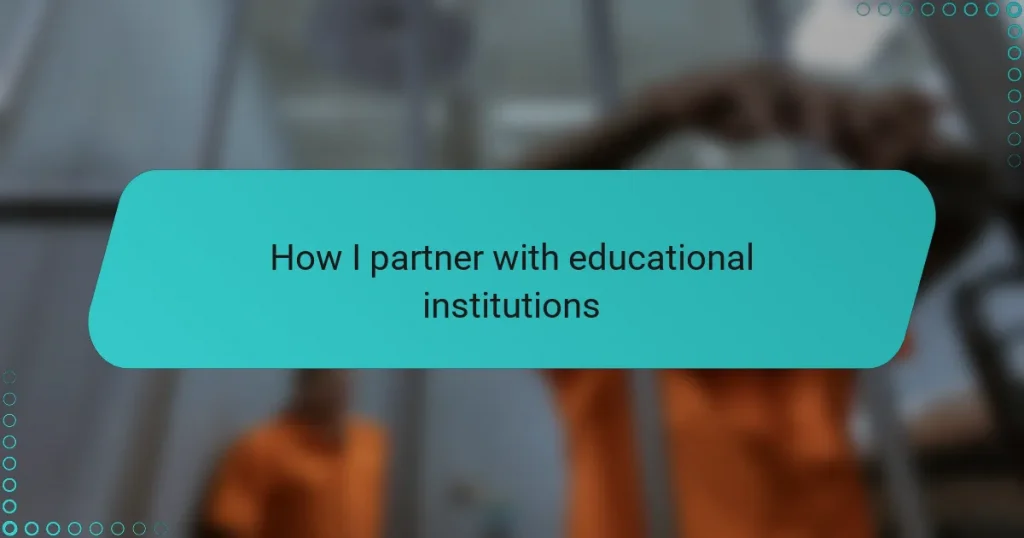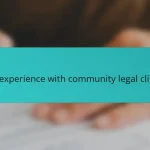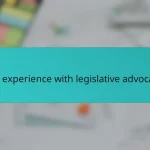Key takeaways
- Legal advocacy in education transforms the learning experience by ensuring students have access to necessary resources and support.
- Partnerships with educational institutions foster proactive solutions and create inclusive environments, promoting dialogue and shared goals.
- Setting clear, realistic goals and regularly revisiting them is crucial for building trust and facilitating lasting change in advocacy efforts.
- Measuring impact focuses on shifts in mindset and confidence among educators, highlighting the importance of collaboration and open communication.
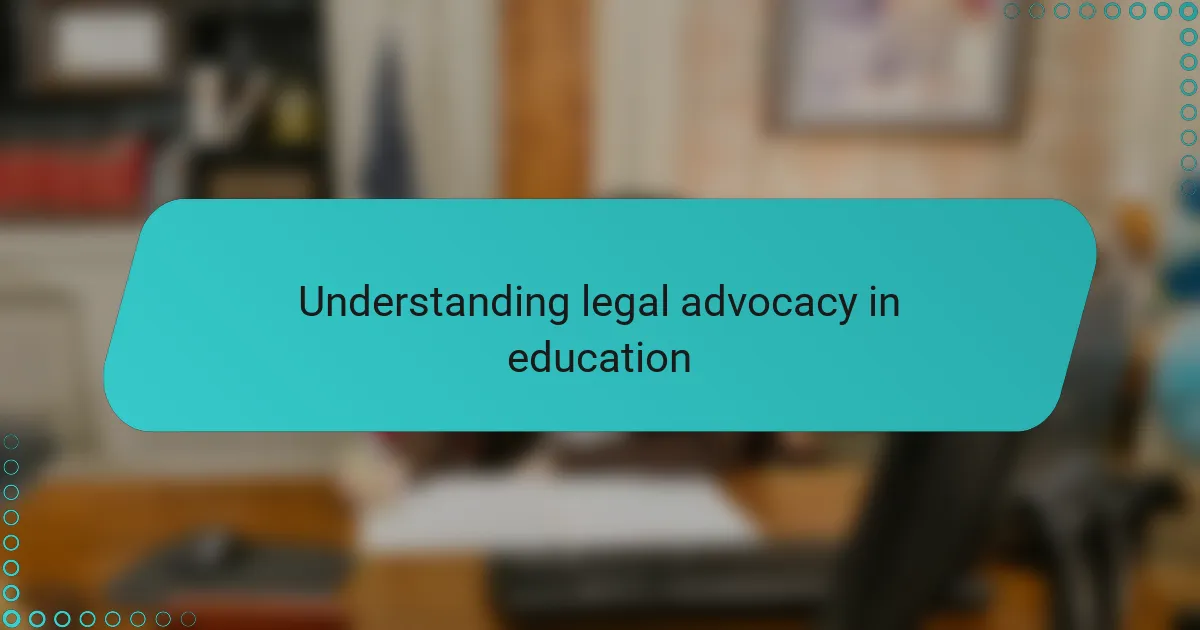
Understanding legal advocacy in education
Legal advocacy in education isn’t just about understanding laws; it’s about recognizing the real-life impact those laws have on students and educators. I remember working with a school where accessing special education services felt like an uphill battle for families—legal advocacy opened doors that otherwise seemed shut. Have you ever considered how the proper application of legal rights can transform a child’s entire learning experience?

Key benefits of partnering with institutions
Partnering with educational institutions creates a bridge between legal knowledge and practical support, which I find incredibly rewarding. When I collaborate directly with schools, I see firsthand how timely guidance can prevent small issues from becoming overwhelming legal disputes. Isn’t it amazing how just a little clarity on rights and responsibilities can ease tensions and build trust within a community?
I’ve noticed that these partnerships open up opportunities for proactive education—teachers and administrators don’t just react to problems; they learn to spot potential barriers early. This shift not only empowers the staff but also creates a safer, more inclusive environment for students. What’s more powerful than knowing you helped shape a school where every child feels protected and valued?
Beyond the immediate benefits, working closely with institutions fosters a culture of ongoing dialogue, which I believe is essential for lasting change. It encourages everyone involved to feel like they have a voice and a partner in advocacy. Have you ever felt the difference it makes when a community rallies together with clear, shared goals? That’s where real progress happens.

Identifying potential educational partners
Finding the right educational partners often starts with looking for institutions that show a genuine commitment to student welfare and equity. I recall a time when a small community college reached out, eager to address disciplinary policies that disproportionately affected minority students—it was clear they wanted more than just guidance; they wanted partnership. How do you recognize an institution’s true interest beyond formal agreements? For me, it’s all about their openness to dialogue and willingness to embrace change.
Sometimes the best partners aren’t immediately obvious. I’ve worked with schools that initially seemed resistant but revealed a deep concern for issues like access to special education or bullying prevention once conversations began. It makes me wonder: what untapped potential lies within institutions that may seem reluctant at first glance? Patience and trust-building often uncover shared goals that truly drive impactful advocacy.
I also look for schools where leadership values collaboration and understands the long-term benefits of legal advocacy—not just avoiding lawsuits but fostering inclusion and fairness. When I see administrators inviting advocacy into strategic planning, it feels like the perfect foundation for meaningful work. Isn’t it encouraging to witness a community ready to invest in proactive solutions rather than reacting to crises? Those are the partnerships that resonate most with me.
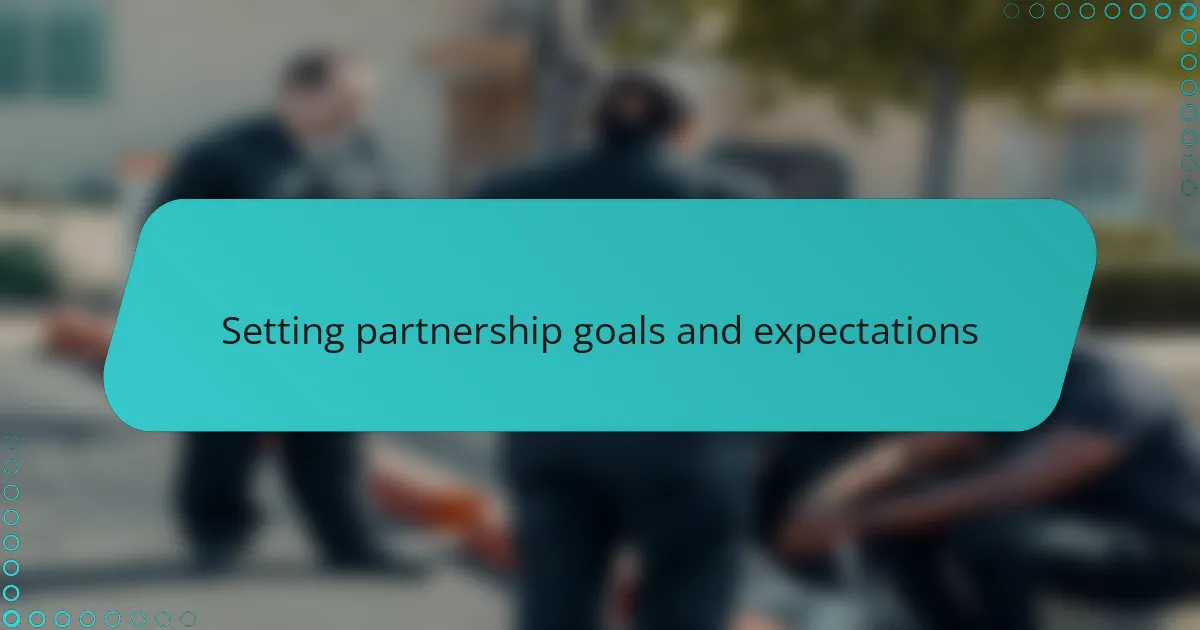
Setting partnership goals and expectations
Setting clear goals with educational partners is where I believe our work truly begins. I remember a meeting with a principal who was initially unsure about what advocacy could achieve, but once we outlined specific objectives—like improving special education access—the whole conversation shifted. Have you ever seen how defining a shared vision can turn hesitation into enthusiasm?
Expectations need to be realistic and mutually understood to build trust. In one instance, a school expected rapid policy changes, but I emphasized the importance of steady progress and ongoing communication; setting those parameters saved the partnership from frustration. What’s your experience with balancing ambition and practicality in collaborations?
I also find it crucial to revisit goals regularly, ensuring they evolve with the institution’s needs. During a long-term project, I noticed that as staff became more confident in legal advocacy, their priorities shifted from compliance to creating inclusive cultures. Doesn’t it feel rewarding to witness growth like that, where partnership goals become catalysts for deeper change?
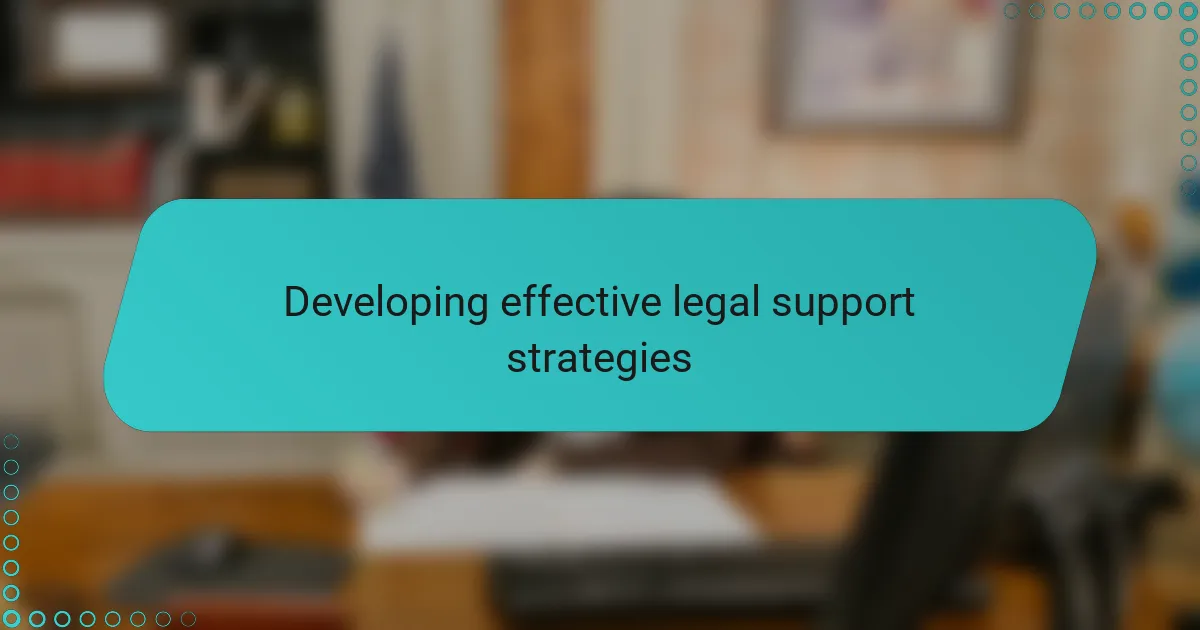
Developing effective legal support strategies
Developing effective legal support strategies starts with listening deeply to the unique challenges an institution faces. I once worked with a district struggling with vague disciplinary procedures, and by tailoring a strategy that combined clear policy language with staff training, we turned confusion into confidence. Have you ever noticed how precision and education together can transform uncertainty into empowerment?
It’s equally important to consider the practical realities on the ground. For example, when partnering with a high school, I realized that simply knowing the law wasn’t enough; we needed easy-to-use tools that teachers and counselors could apply daily. Creating those step-by-step guides made legal concepts accessible, which in my experience, leads to more consistent and proactive support.
What I find most rewarding is how these strategies evolve through collaboration. No plan stays static, and as institutions grow more comfortable, they often suggest new ideas that make legal advocacy more embedded and effective. Isn’t it inspiring when a partnership becomes a dynamic exchange rather than a one-way street? That’s when real progress starts to happen.
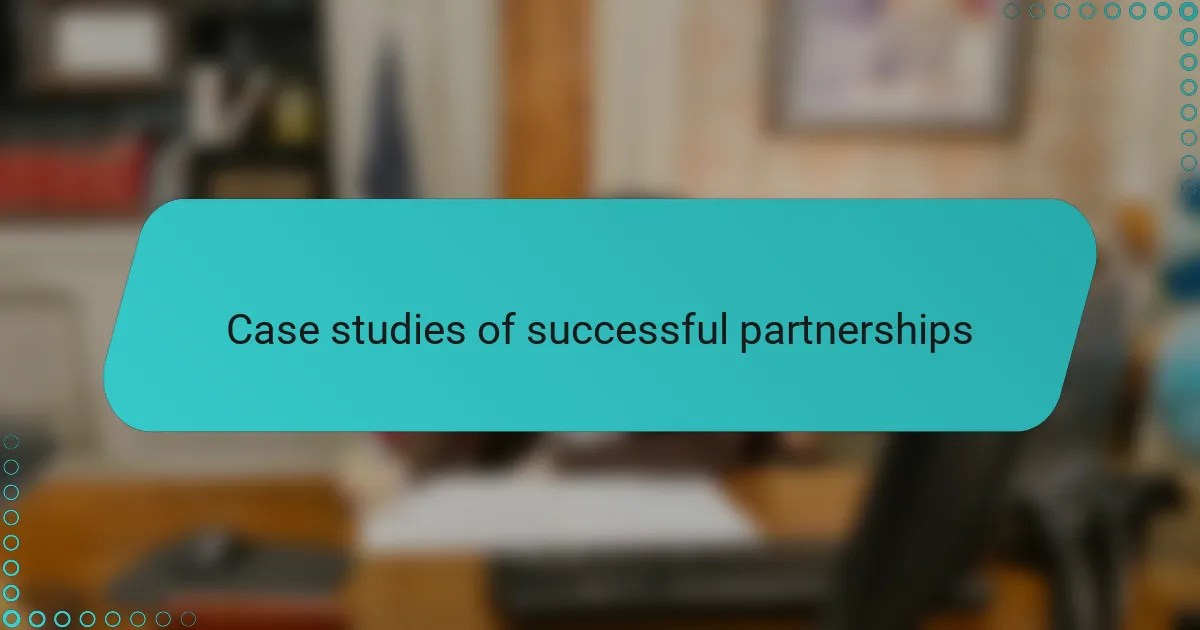
Case studies of successful partnerships
One partnership I hold close involved a rural school district confronting chronic absenteeism tied to students facing legal barriers at home. Together, we crafted a legal advocacy initiative that trained counselors to recognize those barriers early, turning absenteeism from a disciplinary issue into a solvable legal challenge. Have you ever seen how a small shift in perspective can change an entire school’s approach to student support?
Another memorable case was with an urban high school grappling with outdated disciplinary policies that disproportionately impacted minority students. By working hand-in-hand with administrators, we rewrote policies and implemented training that fostered fairness and reduced expulsions significantly. Witnessing the trust build between legal advocates and educators during that process reminded me why partnership is so powerful.
In one unique example, a community college sought help to clarify students’ rights under disability laws—what began as a consultation blossomed into an ongoing collaboration. Over time, I saw faculty gain confidence and start initiating changes themselves, turning legal advocacy from a service into a shared mission. Isn’t it something special when partners evolve beyond dependence into confident advocates for their own communities?
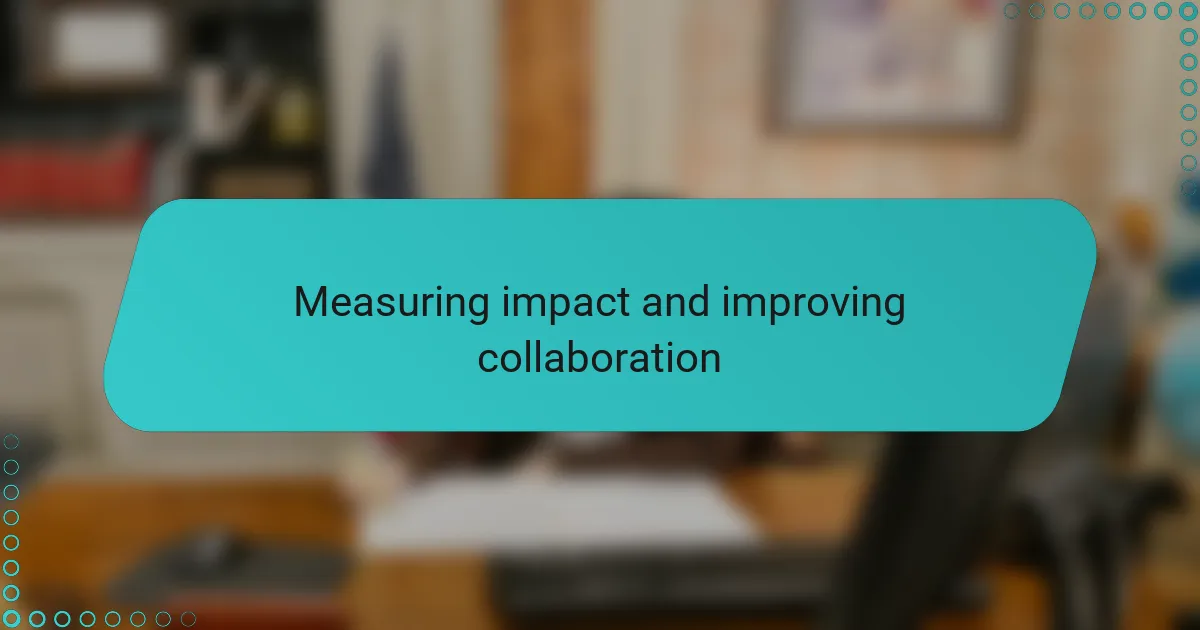
Measuring impact and improving collaboration
Measuring impact is more than just tracking numbers; it’s about seeing real change in how schools respond to legal challenges. I once learned from a partner school that after implementing our recommended strategies, teachers reported feeling more confident advocating for students’ rights—proof that success isn’t always in statistics but in shifting mindsets. How often do we overlook those subtle but powerful shifts when evaluating impact?
Improving collaboration means keeping the conversation alive and honest. I make it a point to schedule regular check-ins, where both sides can share progress, struggles, and ideas without hesitation. Have you noticed how these ongoing dialogues not only fine-tune our approach but also deepen trust, turning partnerships into genuine teamwork?
Sometimes, I find that inviting feedback from frontline staff can unveil opportunities for improvement we might have missed. For example, a counselor’s suggestion to simplify communication materials led to greater engagement from educators and parents alike. Isn’t it fascinating how collaboration thrives when everyone’s voice is heard and valued?
